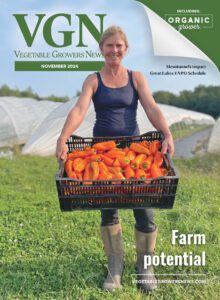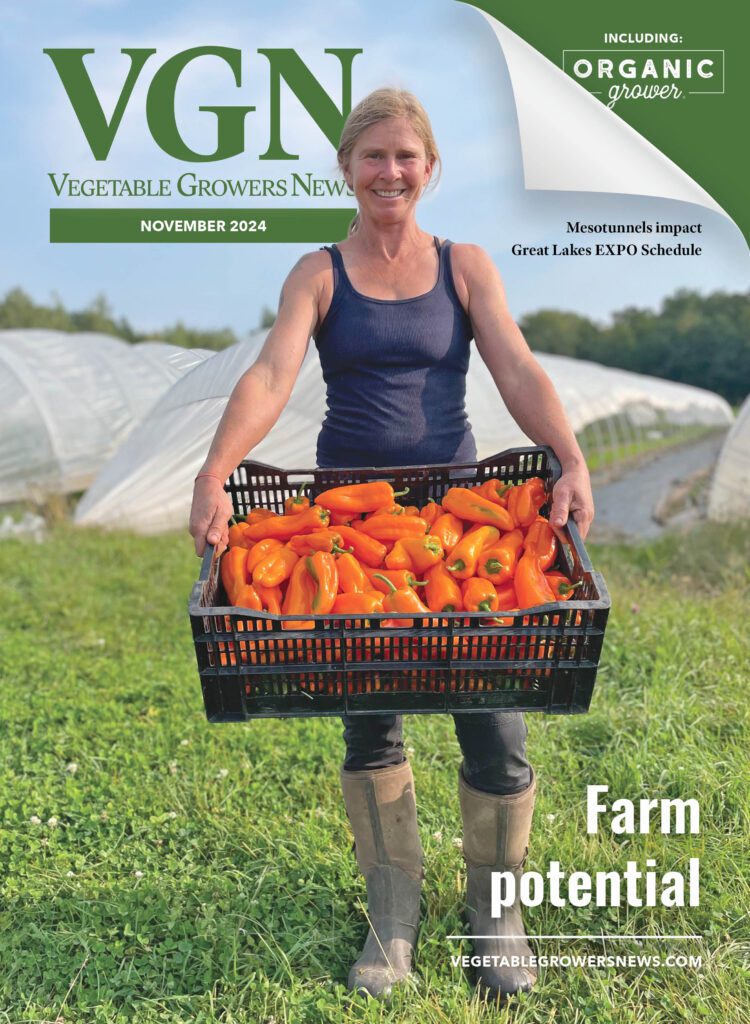Feb 18, 2016Pollination of greenhouse vegetables a challenging endeavor
Ben Phillips advocates the pursuit of a number of techniques to successfully pollinate greenhouse vegetables.
The Michigan State University Extension educator shared pollination tips with growers at the recent Great Lakes Fruit, Vegetable and Farm Market EXPO, held in Grand Rapids, Michigan.
“Growing produce in greenhouses and hoophouses can be an effective and economical venture for early production of warm-season fruiting vegetables, and for winter production of cool-season leaf and root vegetables,” Phillips said. “In addition, these structures are sometimes subsidized by state and federal agencies to support local four-season production of high-value crops.
“However, pollination of fruiting vegetables can be a challenge in enclosed structures,” Phillips said.
Which fruiting vegetable crops work well in the greenhouse? According to Phillips, cucumbers, watermelon, melon, summer squash, tomatoes, peppers, eggplant and beans are great greenhouse candidates for early summer production. Peas can be started early in these structures as well.


For larger fruited vine crops, trellising can be utilized with mechanisms to support the weight of fruits (onion bags, panty hose, etc). Bush type and vine type squash plants can be utilized with extra attention paid to spacing.
Which greenhouse crops require pollination assistance? Standard cucurbits have separate male and female flowers, which require a pollinator to bring pollen from a male flower over to a female flower. Cucurbits naturally produce many more male flowers than female flowers to ensure that bees come in contact with pollen while searching for the larger nectar pots in female flowers.
Phillips said breeding has created different flowering behaviors of these crops. Gynoecious cucumbers have been bred to produce predominately female flowers to maximize yield. But, they require 15 percent interplanting with a conventional “sire” cucumber with the typical number of male flowers. Some seed companies will sell these seeds pre-mixed.
“Seedless cucumbers do not need pollination at all, and pollination will actually cause misshapen fruit,” Phillips said. “But, the female flowers of seedless watermelon still need to receive pollen from a regular seeded diploid watermelon to trigger fruit set. Seedless watermelons require 30 percent interplanting with diploid pollenizers to maximize fruit set and yield. Often, a standard seeded watermelon is used as a pollenizer. Some muskmelons and cantaloupe cultivars can have self-fertile hermaphroditic flowers with both male and female parts, but still require a pollinator.”
Solanaceous crops have both male and female parts on the same “perfect” flower, and can self-pollinate, Phillips said. However, the tubular, downward-facing flowers need to be agitated to release pollen from the male part onto the female part. Though this occurs naturally by wind, pollination can be enhanced with mechanical vibration provided by growers or bees.
“Bumblebees do this particularly well with a technique called ‘sonication,’ wherein they clamp onto the flower tube, and flex their flight muscles to vibrate the pollen out,” Phillips said. “Environmental conditions can greatly affect the quality and quantity of pollen release to the female part of the plant. Tomatoes and peppers need nighttime temperatures between 55˚-70˚ F to produce pollen, and daytime temps should not exceed 90˚ F. Flowers will abort completely after four hours over 100˚ F.”
In addition, relative humidity should be between 50-80 percent to prevent pollen from being too dry to stick to the female part or too sticky to fall away from the male parts, Phillips said. Some parthenocarpic varieties exist that set fruit in cooler temperatures without pollen transfer.
“Beans are also perfect flowers, and lima beans fully self-pollinate before flowers open,” he said. “But bees can boost yields of pole beans, snap beans, green beans, and are necessary for setting pods in scarlet runner beans. Due to the complicated flowers of legumes, bees must learn to pollinate them.”
Enclosed structures
There are four primary managed pollinators used in agriculture, with different propensities for use in enclosed structures. All bees can see ultraviolet light, and use it for orienting to their surroundings.
Among the types of structures to grow in, those covered in a material that allow the transmission of UV light are the most preferable, such as glass, polymethacrylate (PMMA), and polyethylene (PE). Polyvinyl chloride (PVC) and polycarbonate (PC) tend to block UV light and disorient bees.
“Honeybees (Apis mellifera) are the most commonly used pollinator for fruiting vegetables inside and outside the greenhouse, but can be difficult to keep under the glass or plastic of growth structures for a number of reasons,” Phillips said.
“Successfully managing honeybees is a full-time job on its own,” he said. “If a grower decided to use mini-nucs, or a full size colony, those bees are just going to explode in numbers and swarm without proper management. You need to be ahead of them all the time. By outsourcing the beekeeping to someone else, they may need to consider how much access to grant to an individual or team of beekeepers to the greenhouse(s).”
The traditional hives are heavy and hard to move, and so smaller nucleus and micro- nucleus colonies are used. But, these need to be managed carefully to avoid swarming, absconding and overheating, he said. In addition, they are the most aggressive managed pollinator, and would not suit an operation where people need to work close by. “Keeping a hive outside of the greenhouse can provide a source of bees to enter and exit structures through vents or roll-up sides, and they can be trained to find crops under plastic and glass with sugar baits,” Phillips said. “But, the first honeybees tend to become disoriented in these structures and get trapped, before other members of the colony get used to navigating inside. On cloudy days they don’t forage as well, which is a poor feature for vine crops that bloom for one day.”


Commercial bumblebees (Bombus spp) have been an emerging market for pollination inside structures in Europe and North America, Phillips said.
Bumblebees live in much smaller colonies, making them easier to transport. Phillips said companies, such as Koppert Biological Systems, and Biobest, have devised ways to rear them continually through the winter in artificial environments for seasonal production needs across the continent, and have designed special packaging enabling them to be shipped through the mail with a food source.
“The bees are less aggressive than honeybees, and can fly under glass and plastic without getting trapped,” Phillips said. “They are effective pollinators of vine crops and solanaceous crops inside and outside growth structures, but are short-lived (less than 8-12 weeks).”
Growers can determine the visitation level of bumblebees on tomatoes and peppers by the bruising that occurs on the anther cone of the flower: the darker the bruise, the longer the visit and more effective pollination, Phillips said.
Bumblebees have also been shown to successfully pollinate muskmelons in New Zealand greenhouses, and are one of the most prominent wild pollinators of field-grown squashes.
“If too few flowers are in the greenhouse they will forage outside to supplement their diet, but will return when flowers are more plentiful,” he said.
Current recommendations are four to six colonies per acre of enclosed space. For a 30 x 48 feet up to a 30 x 192 feet greenhouse, one bumblebee colony would be more than adequate for a tomato, pepper, or vine crop, Phillips said
Solitary cavity nesting bees are supported by a smaller industry than honeybees and bumblebees.
“But they are the least aggressive commercial bees, rarely sting, are more effective pollinators of particular crops and have potential for indoor use,” he said.
Mason bee (Osmia spp) life cycles are limited to flight in April-June, and they are used for early blooming tree fruit. They have been successfully used in pollination of brassica crops for seed production in cages and high-tunnel strawberries. One species was found to be successful as indoor pollinators of peppers in Denmark, but could not maintain adequate nutrition to provide continued pollination of later flowers.
“Multiple pollen sources may be an important factor for some species of mason bees, and access to wet soil will help them to construct nests,” he said. “Leafcutter bees (Megachile spp) are solitary cavity nesting bees, and a complex of species span the summer months, using leaf cuttings to partition their nests.
“They visit a larger diversity of flowers than mason bees, and are used widely in seed production of field-grown alfalfa,” Phillips said. “They have also been successfully experimented with in field-grown lowbush blueberry production in Maine. Greenhouse studies with these bees concluded that high light levels and temperatures around 80˚ F are important factors influencing their flight activity. In cucumbers, they were found to prefer the uppermost flowers in the brightest area of the structure, and they needed alternative softer-leaved plants to construct their nests.”
— Gary Pullano, associate editor














